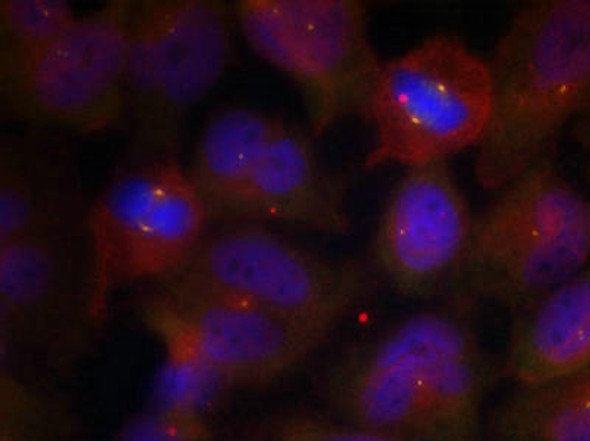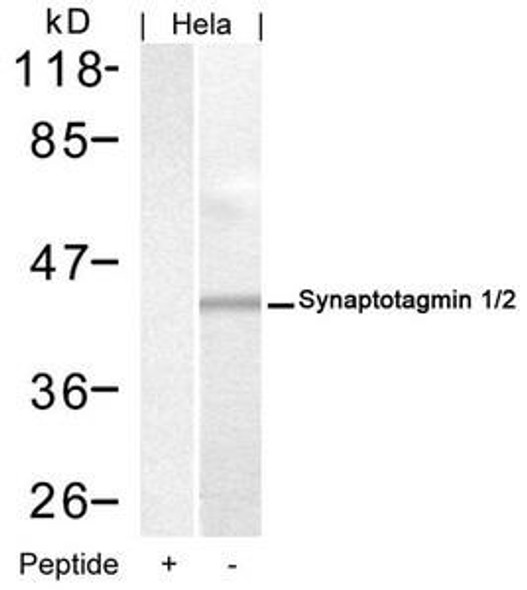Phospho-SYT1/SYT2 (S309/306) Antibody (PACO00294)
- SKU:
- PACO00294
- Product Type:
- Antibody
- Reactivity:
- Human
- Mouse
- Rat
- Host Species:
- Rabbit
- Isotype:
- IgG
- Applications:
- ELISA
- WB
- IHC
- Antibody Type:
- Polyclonal Antibody
- Conjugation:
- Unconjugated
Description
Phospho-SYT1/SYT2 (S309/306) Antibody (PACO00294)
The Phospho-Syt1/Syt2 (S309/306) Antibody (PACO00294) is a valuable tool for researchers studying synaptic transmission and calcium signaling pathways. This antibody specifically recognizes phosphorylated forms of Synaptotagmin 1 and Synaptotagmin 2 at Serine 309 and 306, respectively. Raised in rabbits, this antibody is highly reactive with human samples and has been validated for use in Western blot applications.Synaptotagmins are crucial proteins involved in calcium-dependent neurotransmitter release at synapses. Phosphorylation at specific sites like S309 and S306 can modulate the function of Synaptotagmins, impacting synaptic vesicle fusion and neurotransmitter release.
Understanding the regulation of these proteins is essential for unraveling the complexities of synaptic transmission and neuronal communication.This antibody's ability to specifically detect phosphorylated forms of Synaptotagmin 1 and Synaptotagmin 2 makes it a valuable tool for researchers investigating synaptic plasticity, neuronal communication, and neurological disorders. By enabling accurate detection and analysis of phosphorylated Synaptotagmins, this antibody contributes to advancing our understanding of the molecular mechanisms underlying brain function and dysfunction.
| Antibody Name: | Phospho-SYT1/SYT2 (S309/306) Antibody |
| Antibody SKU: | PACO00294 |
| Size: | 50ug |
| Host Species: | Rabbit |
| Tested Applications: | ELISA, WB, IHC |
| Recommended Dilutions: | WB:1:500-1:2000, IHC:1:100-1:300 |
| Species Reactivity: | Human, Mouse, Rat |
| Immunogen: | synthesized peptide derived from human Synaptotagmin 1/2 around the phosphorylation site of S309/306. |
| Form: | Liquid |
| Storage Buffer: | Liquid in PBS containing 50% glycerol, 0.5% BSA and 0.02% sodium azide. |
| Purification Method: | The antibody was affinity-purified from rabbit antiserum by affinity-chromatography using epitope-specific immunogen. |
| Clonality: | Polyclonal |
| Isotype: | IgG |
| Conjugate: | Non-conjugated |
| Synonyms: | SYT1; SVP65; SYT; Synaptotagmin-1; Synaptotagmin I; SytI; p65; SYT2; Synaptotagmin-2; Synaptotagmin II; SytII |
| UniProt Protein Function: | SYT1: an integral membrane protein of synaptic vesicles thought to serve as a Ca(2+) sensor in the process of vesicular trafficking and exocytosis. Calcium binding to synaptotagmin I participates in triggering neurotransmitter release at the synapse. Binds acidic phospholipids with a specificity that requires the presence of both an acidic head group and a diacyl backbone. A Ca(2+)-dependent interaction between synaptotagmin and putative receptors for activated protein kinase C has also been reported. It can bind to at least three additional proteins in a Ca(2+)-independent manner; these are neurexins, syntaxin and AP2. |
| UniProt Protein Details: | Protein type:Membrane protein, integral; Vesicle; Calcium-binding Chromosomal Location of Human Ortholog: 12cen-q21 Cellular Component: neuron projection; plasma membrane; synaptic vesicle; synaptic vesicle membrane Molecular Function:calcium ion binding; calcium-dependent phospholipid binding; clathrin binding; low-density lipoprotein receptor binding; phosphatidylinositol binding; phosphatidylinositol-4,5-bisphosphate binding; protein binding; SNARE binding; syntaxin-1 binding Biological Process: calcium ion-dependent exocytosis of neurotransmitter; detection of calcium ion; glutamate secretion; neurotransmitter secretion; positive regulation of synaptic transmission; protein homooligomerization; regulation of calcium ion-dependent exocytosis; regulation of exocytosis; regulation of synaptic transmission, glutamatergic; synaptic transmission; synaptic vesicle endocytosis; vesicle fusion |
| NCBI Summary: | The synaptotagmins are integral membrane proteins of synaptic vesicles thought to serve as Ca(2+) sensors in the process of vesicular trafficking and exocytosis. Calcium binding to synaptotagmin-1 participates in triggering neurotransmitter release at the synapse (Fernandez-Chacon et al., 2001 [PubMed 11242035]).[supplied by OMIM, Jul 2010] |
| UniProt Code: | P21579 |
| NCBI GenInfo Identifier: | 135086 |
| NCBI Gene ID: | 6857 |
| NCBI Accession: | P21579.1 |
| UniProt Secondary Accession: | P21579,Q6AI31, |
| UniProt Related Accession: | P21579 |
| Molecular Weight: | 47,573 Da |
| NCBI Full Name: | Synaptotagmin-1 |
| NCBI Synonym Full Names: | synaptotagmin 1 |
| NCBI Official Symbol: | SYT1 |
| NCBI Official Synonym Symbols: | P65; SYT; SVP65 |
| NCBI Protein Information: | synaptotagmin-1 |
| UniProt Protein Name: | Synaptotagmin-1 |
| UniProt Synonym Protein Names: | Synaptotagmin I; SytI; p65 |
| Protein Family: | Synaptotagmin |
| UniProt Gene Name: | SYT1 |
| UniProt Entry Name: | SYT1_HUMAN |











